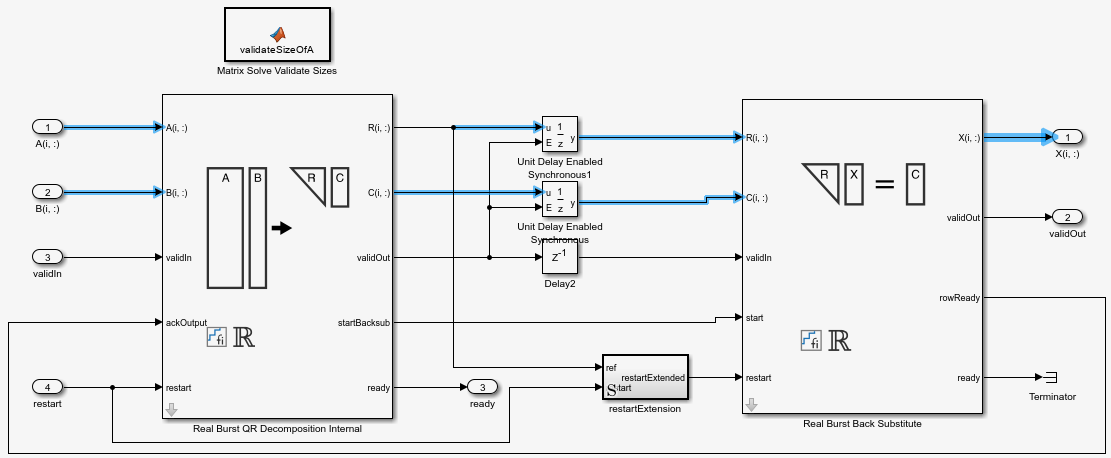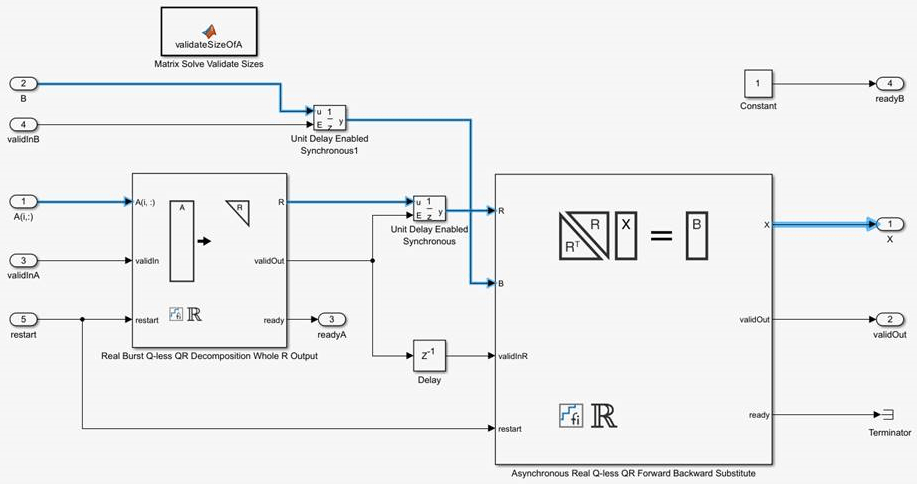Choose a Block for HDL-Optimized Fixed-Point Matrix Operations
You can use the Fixed-Point Designer™ HDL Support library of blocks to perform fixed-point matrix operations and generate efficient HDL code. These blocks model design patterns for systems of linear equations and core matrix operations, such as QR decomposition and singular value decomposition, for hardware-efficient implementation on FPGAs. For an introduction to these concepts, see Factorizations and Singular Values.
This topic discusses how to choose an appropriate block from the Fixed-Point Designer HDL Support library for your application.
Define the Problem to Solve
First, define the math problem that you need to solve and the algorithm to use.
Linear System Solvers
Use the Linear System Solver library of blocks to solve these systems of linear equations.
| Operation | Blocks | Description |
|---|---|---|
| Ax = B | Matrix Solve Using QR Decomposition blocks | Use QR decomposition to solve the system of linear equations Ax = B. To compute x = A-1, set B to be the identity matrix. |
| A'AX = B | Matrix Solve Using Q-less QR Decomposition blocks | Solve the system of linear equations A'AX = B using QR decomposition, without computing Q. |
| A'AX = B | Matrix Solve Using Q-less QR Decomposition with Forgetting Factor blocks | Solve the system of linear equations A'AX = B using QR decomposition, without computing Q. A is an infinitely tall matrix representing streaming data. |
Matrix Factorizations
Use the Matrix Factorizations library of blocks to perform QR decomposition, also known as QR factorization.
| Operation | Blocks | Description |
|---|---|---|
QR decomposition | QR Decomposition blocks | Use QR decomposition to compute R and C=Q'B, where QR=A, where A and B are your input matrices. The least-squares solution to Ax=B is x=R\C. R is an upper-triangular matrix and Q is an orthogonal matrix. To compute C=Q', set B to be the identity matrix. |
QR decomposition without computing Q | Q-less QR Decomposition blocks | Use Q-less QR decomposition to compute the economy size upper-triangular R factor of the QR decomposition A = QR, without computing Q. The solution to A'Ax = B is x = R\R'\b. |
QR decomposition without computing Q and an infinite number of rows | Q-less QR Decomposition with Forgetting Factor blocks | Use Q-less QR decomposition to compute the economy size upper-triangular R factor of the QR decomposition A = QR, without computing Q. A is an infinitely tall matrix representing streaming data. |
Singular value decomposition | Jacobi SVD HDL Optimized blocks | Use the Jacobi SVD HDL Optimized blocks to compute the singular value decomposition of a matrix A using the two-sided Jacobi algorithm. |
Choose an Architecture
Blocks in the Fixed-Point Designer HDL Support > Matrices and Linear Algebra library are available in burst, partial-systolic, and systolic implementations. Systolic implementations prioritize speed of computations over space constraints, while burst implementations prioritize space constraints at the expense of speed of the operations. Systolic implementations minimize system latency and increase the throughput, but require more hardware resources than burst or partial-systolic implementations. The following table illustrates the tradeoffs between the implementations available for matrix decompositions and solving systems of linear equations.
| Implementation | Throughput | Latency | Area |
|---|---|---|---|
| Systolic | C | O(n) | O(mn2) |
| Partial-Systolic | C | O(m) | O(n2) |
| Partial-Systolic with Forgetting Factor | C | O(n) | O(n2) |
| Burst | O(n) | O(mn) | O(n) |
Where C is a constant proportional to the word length of the data, m is the number of rows in matrix A, and n is the number of columns in matrix A.
Linear System Solvers: Select Synchronous or Asynchronous Operation
The Matrix Solve Using QR Decomposition blocks operate synchronously. These blocks first decompose the input A and B matrices into R and C matrices using a QR decomposition block. Then, a back substitute block computes RX = C. The input A and B matrices propagate through the system in parallel, in a synchronized way.

The Matrix Solve Using Q-less QR Decomposition blocks operate asynchronously. First, Q-less QR decomposition is performed on the input A matrix and the resulting R matrix is put into a buffer. Then, a forward backward substitution block uses the input B matrix and the buffered R matrix to compute R'RX = B. Because the R and B matrices are stored separately in buffers, the upstream Q-less QR decomposition block and the downstream Forward Backward Substitute block can run independently. The Forward Backward Substitute block starts processing when the first R and B matrices are available. Then it runs continuously using the latest buffered R and B matrices, regardless of the status of the Q-less QR Decomposition block. For example, if the upstream block stops providing A and B matrices, the Forward Backward Substitute block continues to generate the same output using the last pair of R and B matrices.

The Burst (Asynchronous) Matrix Solve Using Q-less QR Decomposition blocks are available in both synchronous and asynchronous operation variants, as denoted by the block name.
Data Complexity
All blocks in the Fixed-Point Designer HDL Support > Matrices and Linear Algebra library are available in real and complex variants. Choose the real or complex variant of the block based on the complexity of your data.
Hardware Control Signals
Restart Signal
Some blocks in the Fixed-Point Designer HDL Support > Matrices and Linear Algebra library provide an input reset signal that clears internal states.
AMBA AXI Handshake Process
Blocks in the Fixed-Point Designer HDL Support > Matrices and Linear Algebra library use the AMBA
AXI handshake protocol [1]. The valid/ready handshake process is used
to transfer data and control information. This two-way control mechanism allows both the
manager and subordinate to control the rate at which information moves between manager and
subordinate. A valid signal indicates when data is available. The
ready signal indicates that the block can accept the data. Transfer
of data occurs only when both the valid and ready
signals are high.
References
[1] "AMBA AXI and ACE Protocol Specification Version E." https://developer.arm.com/documentation/ihi0022/e/AMBA-AXI3-and-AXI4-Protocol-Specification/Single-Interface-Requirements/Basic-read-and-write-transactions/Handshake-process
See Also
Blocks
- Real Burst Matrix Solve Using QR Decomposition | Real Partial-Systolic Matrix Solve Using Q-less QR Decomposition | Complex Burst Q-less QR Decomposition Whole R Output | Complex Partial-Systolic Q-less QR Decomposition with Forgetting Factor | Square Jacobi SVD HDL Optimized
Topics
- Implement Hardware-Efficient Real Burst Matrix Solve Using QR Decomposition
- Implement Hardware-Efficient Real Burst Matrix Solve Using Q-less QR Decomposition with Tikhonov Regularization
- Implement Hardware-Efficient Complex Partial-Systolic QR Decomposition
- Implement Hardware-Efficient Real Burst Q-less QR with Forgetting Factor
- Algorithms to Determine Fixed-Point Types for Real Least-Squares Matrix Solve AX=B
- Determine Fixed-Point Types for Real Least-Squares Matrix Solve AX=B